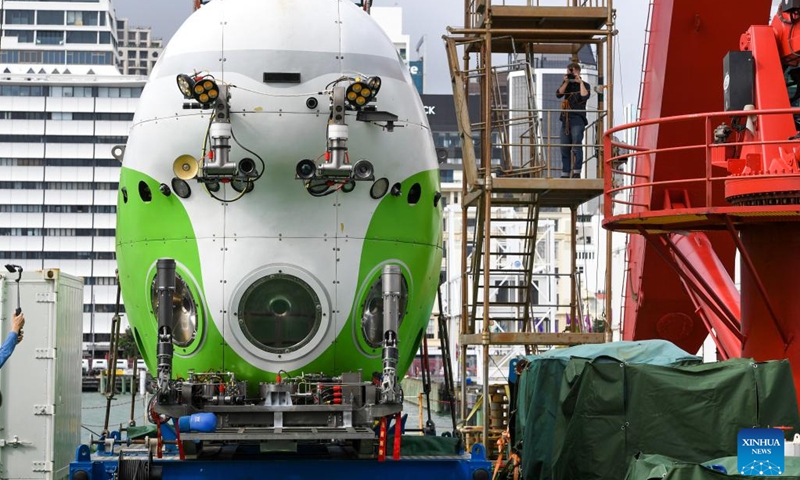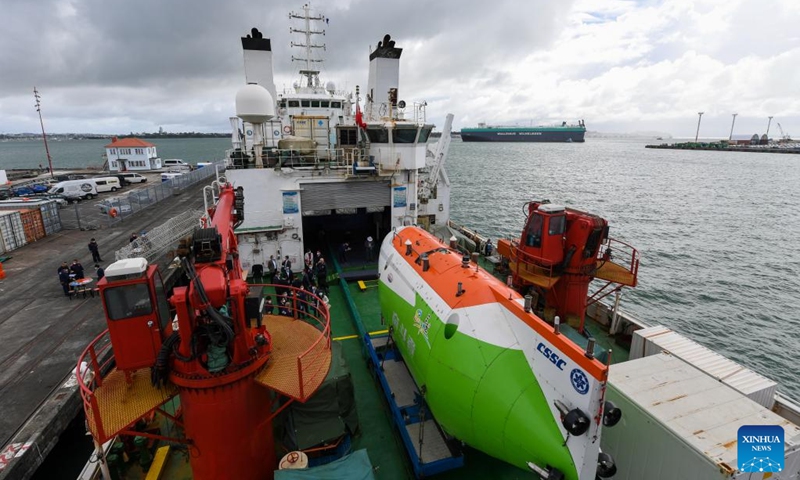
Submersible pilots Deng Yuqing (C) and Yuan Xin (L) from China's Institute of Deep-Sea Science and Engineering (IDSSE) of the Chinese Academy of Sciences, and New Zealand Marine biologist Dr. Kareen Schnabel from the National Institute of Water and Atmospheric Research, prepare for their expedition to the Kermadec Trench onboard China's research vessel Tansuoyihao, Nov. 4, 2022.(Photo: Xinhua)

China's research vessel Tansuoyihao loaded with the Human Occupied Vehicle Fendouzhe docks at Queens Wharf in Auckland, New Zealand, Nov. 27, 2022.(Photo: Xinhua)

China's research vessel Tansuoyihao loaded with the Human Occupied Vehicle Fendouzhe docks at Queens Wharf in Auckland, New Zealand, Nov. 27, 2022.(Photo: Xinhua)

China's research vessel Tansuoyihao loaded with the Human Occupied Vehicle Fendouzhe docks at Queens Wharf in Auckland, New Zealand, Nov. 27, 2022.(Photo: Xinhua)
New Zealand Marine biologist Dr. Kareen Schnabel from the National Institute of Water and Atmospheric Research (NIWA) on Sunday used "incredible" many times to describe her unique experience with her Chinese counterparts and Human Occupied Vehicle (HOV) Fendouzhe after their expedition to one of the deepest regions in the ocean on Sunday.
The successful dive was undertaken together by Schnabel and submersible pilots Deng Yuqing and Yuan Xin from China's Institute of Deep-Sea Science and Engineering (IDSSE) of the Chinese Academy of Sciences.
During the expedition, Schnabel and Deng become the first women to bottom down the Scholl Deep in the Kermadec Trench.
It was only the second crewed visit ever to explore the Scholl Deep of Kermadec Trench and was done as part of a two-month scientific voyage onboard the IDSSE's research vessel Tansuoyihao.
The Scholl Deep is the deepest known point of the Kermadec Trench, more than 1,000 km to the northeast of New Zealand. The trench is over 1,000 km long and its deepest point is at a depth greater than the height of Mount Qomolangma.
Using the HOV Fendouzhe, scientists collected deep-sea water samples, sediments, rocks, biological samples, and environmental data.
Dr. Schnabel and the submersible pilots spent six hours at the bottom of the sea exploring the Scholl Deep and the steep sides of the trench.
"Textbooks and images don't compare to experiencing the light disappearing as you leave the surface of the ocean or seeing the deep sea floor with your own eyes. The fine sediments were covered in tracks, and we saw lots of small animals on the sea floor and in the water. It was jarring that there was still rubbish such as fishing floats and nets, even though we were more than 10,000 m below sea level," Schnabel said.
The first leg of the voyage was completed after HOV Fendouzhe undertook 16 dives between 5,747 m and 10,000 m in depth, in addition to the deployment of other independent samplers such as a lander, CTD (water sampler), and a gravity corer.
"It is really exciting for both Chinese and New Zealand scientists to have the opportunity to comprehensively appreciate the complexity and diversity of the geo and ecosystem of the Kermadec Trench," Dr. Peng Xiaotong, the leader of this voyage from IDSSE said.
"Taking rock samples, for example, offers us a unique chance to understand the nature of the subducting and overriding plate, as well as the mechanism of the subduction initiation in Kermadec Trench," Peng said.
"We saw highly diverse sea floor communities even at great depths and discovered strange and rarely seen organisms such as the upside-down angler fish. As we go deeper into the trench, seafloor ecosystems become dominated by small organisms, which will need to be examined using light and electron microscopy back on land."
Chinese ambassador Wang Xiaolong highlighted the expedition as a journey of exploration, friendship as well as a journey of seeking cooperation, which provides an important platform for China-NZ marine collaboration.
This point was also echoed by Dr. Schnabel. "Fendouzhe is an incredible piece of equipment that provides scientists from all over the world the opportunities to observe the environment like Kermadec Trench. I hope the scientific collaboration between the two countries will continue in future."
